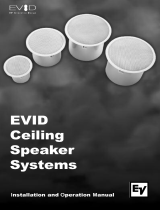
7
Figure 16:
Tap Selector
(Shown: Control 14C/T. Tap ratings on the
other models differ from these gures.)
Step 9 – Insert the Grille – Consider which direction the
logo is facing and press the grille into place until the front of the
grille is ush with the rim. It is oen easiest to press in various
places around the perimeter of the grille. Make sure grille is
securely seated to prevent it from vibrating loose and falling.
Removing the Grille -- e grille presents a tight t in order
to make sure that it won’t fall out, even with high vibrations
that can be produced by these speakers. If you need to
remove the grille, it is easiest to do so by inserting 2 pointed
objects (such as push pins) into 2 nearby holes in the grille,
presenting slow even pressure to pull down on the grille until
that section of the grille comes out approximately 6 mm (1/4
inch) . Work your way around the grille, loosening a section
at a time until the grille comes out.
Painting the Speaker
e speaker’s textured white nish complements most decor
and does not need further nishing. Where the interior design
requires it, these speakers are easy to paint.
e rim can be painted before installation or in cases where the
rim needs to be nished along with the ceiling, the speaker rim
can be painted aer attaching into the ceiling.
Type of Paint – e speaker’s ABS rim accepts almost any type
of latex or oil based paint. Two coats are recommended.
Painting Process – For best results, the following procedure is
recommended:
• Clean the rim and grille with a light solvent such as mineral
spirits by rubbing the item with a lightly dampened cloth. Do
not, however, use abrasives such as sandpaper or steel wool. Nor
should you use gasoline, kerosene, acetone, MEK, paint thinner,
harsh detergents or other chemicals. Use of these cleaners may
result in permanent damage to the enclosure.
• Aer cleaning, apply two or more thin coats of either latex
or oil-based paints. Latex paint will adhere best if an oil-based
primer is used rst. Application can be made by rolling, brush-
ing or spraying.
Painting the Speaker Along With the Ceiling – Insert the clear
plastic paint shield into the front of the speaker to mask the
drivers and internal bae, paint the speaker, then remove the
shield.
Painting the Grille – Painting the grille requires removal of the
logo prior to painting (the logo should be stuck back onto the
grille aer painting, making sure it is located in the exact center
of the grille).
e backing to the grille is glued in place so that it can’t interfere
with the movement of the woofer cone. Leave the grille backing
in place. Spray the grille lightly using thinned paint. Make
sure the spray is light enough that when the grille is held up to
the light, you can still see light through the grille holes (which
means that sound can also get through). Spray only the front of
the grille, not the back. Rolling or brushing the paint is discour-
aged because the mesh and/or backing may become clogged
with paint and poor sound quality may result, however using a
very short-napped roller can be made to work.
Safety Agency Compliance
S7232
LISTED
15CM
Signaling Speaker
UL-2043 Fire Tests for Heat and Visible Smoke Release for
Discrete Products and their Accessories Installed in Air Han-
dling Spaces, NFPA-70 National Electric Code 1996, Article
300-22(C), and NFPA-90A Installation of Air Conditioning and
Ventilation Systems, Section 2-3.10.1 (a), Exception 3. List-
ed UL1480-6 Speakers for Fire Protective Signaling Systems.
SUITABLE FOR USE IN AIR HANDLING SPACES.
ese products are in compliance with the EMC Directive
89/336/EEC and Article 10 (1) of the directive. In compliance
with Technical Regulations EN50081-1 and EN50082-1. For a
copy of the model-specic CE Declaration of Conformity, con-
tact JBL at the address listed at the end of this manual.









